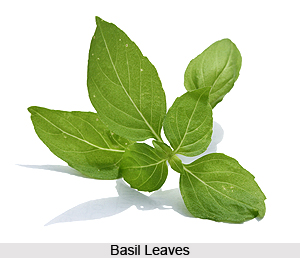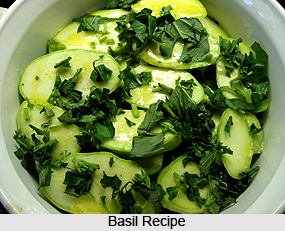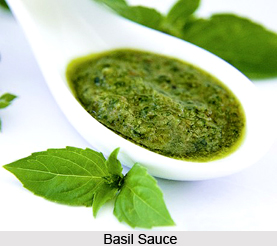 Basil also known as French Basil or Sweet Basil or Tulsi is an erect glabrous herb, 30-90 cm high is very common to India and its culture. The leaves of basil have numerous oil glands with aromatic volatile oil. The herb bears cluster of small white lipped flowers in racemes. The freshly picked bright green leaves turns brownish green when dried and become brittle and curled. American Basil, French Basil, Egyptian Basil and Indian Basil are its major types.
Basil also known as French Basil or Sweet Basil or Tulsi is an erect glabrous herb, 30-90 cm high is very common to India and its culture. The leaves of basil have numerous oil glands with aromatic volatile oil. The herb bears cluster of small white lipped flowers in racemes. The freshly picked bright green leaves turns brownish green when dried and become brittle and curled. American Basil, French Basil, Egyptian Basil and Indian Basil are its major types.
These plants are small mint plant considered sacred by the Hindus in India. In spite being used commonly in certain Hindu rituals, it is a matter of surprise that its references are not found in any of the ancient Vedic literatures. It is probable that the Hindus from Austric culture due to its medicinal and other virtues might have adopted the plant. In fact it is said that the term Tulsi has been derived from Austric term.
The mythological story that describes its origin also has Austric linkage. It is said an ancient queen known as Tulsi was the consort of the Austric King Sankhachud. She was so devoted to her husband that due to this she could acquire certain divine power, which was sufficient to protect her husband in wars. Consequently King Sankhachud became a powerful leader defeating the Devas or the gods in the wars they faced. In order to destroy him, Lord Vishnu came in disguise of Sankhachud and approached Tulsi. Thinking that her husband has come home she gave away and Vishnu went for sexual intercourse with her thereby destroyed her divine power. Thus finally Sankhachud was destroyed, Tulsi committed suicide not before cursing Vishnu that he shall turn into a stone. Lord Vishnu repented and blessed Tulsi that she will turn into a sweet smelling tree and all worships of Vishnu shall be conducted only with leaves of this tree. The practice since then continues even till date with Vishnu being worshipped as stone with leafs of Tulsi plant.
The plant is grown almost in every Hindu house in India preferably Ocimum sanctum or Krishna Tulsi species. Only when this species are not available other species are planted. In fact even in sophisticated urban houses this is practiced. Every housewife in fact worships this plant every evening. The plant is not only considered as sacred but is also considered as important source of medicine and disinfectant. Tulsi has natural antibiotical properties. All the varieties of Tulsi grow wild in India irrespective of soil, environment and ecosystem. In spite of this situation the plant is not considered as part of the commercial cultivation nor its virtues are ever exploited in India.
Even though in world trade its leaves are considered as important spice it is not so in India and Indians rarely add the leaves of Tulsi to their food except in case of offerings to their deities. The `Basilicum` species are cultivated commercially in Southern France, other Mediterranean countries and also in the USA. Dried leaves and tender four sided stems of this plant are used as spice for flavoring and for recovery of essential oil. The flavor is warm, sweet and somewhat pungent and peculiar. The odor of sweet basil is aromatic fragrant and sweet.
 The leaves have numerous dot-like glands in which the aromatic volatile oil of the herb is contained. The herb bears cluster of small, white, two-lipped flowers in raceme fashion.
The leaves have numerous dot-like glands in which the aromatic volatile oil of the herb is contained. The herb bears cluster of small, white, two-lipped flowers in raceme fashion.
Most of the basil or Tulsi species possesses a clove like scent with an aromatic and somewhat saline taste. However `Kilimandscharicum` species gives camphor like odor and its essential oil tend to crystallize just like camphor.
The characteristics and composition of oil from different regions vary as briefly discussed below. Four types of oil are recognized in commercial term in world market which are as follows:
European Type:Distilled from O. basilicum grown in Europe and America and commonly known as oil of sweet basil; it contains methyl chavicol as the principal constituent and linalool, but no camphor; it is highly prized for its fine odor.
Reunion Type:Distilled originally in Reunion Island, but now produced in Comorros, Malagasy [Madagascar] and Seychelles Island from plants of doubtful nomenclature; the oil contains methyl chavicol and camphor, but no linalool. It is considered inferior to the European oil.
Methyl Cinnamate Type:Distilled in Bulgaria, Sicily, Egypt, India and Haiti; it contains methyl chavicol, linalool and a substantial amount of methyl cinnamate, but no camphor.
Eugenol Type:Distilled in Java, Seychelles, Samoa and Russia. It contains eugenol as the main constituent.
Oil of basil is produced by the distillation of the herb. The flowers, leaves or/and whole herbs are packed into a distillation unit and hydro distilled or steam distilled. It takes in all, about four hours to complete one charge. Standard distillation plants are now available for the purpose, which can be adopted for commercial implementation.
The herb is popularly used for flavoring sups, meat and fish dishes, certain cheeses, tomato cocktail and so on. Sweet basil from Italy is known for its quality. In Italy, basil is an important seasoning in tomato paste products. Similarly the essential oil is also used for flavoring not only food items but also in various dental and oral products.
The herb is well known for the medicinal virtues. In India it is believed that `sanctum` species or the sacred basil has better medicinal virtues than other species. It is also believed that the plant releases electro-magnetic influences around it, hence planting it in the courtyard shall make people of the house remaining happy. It is also considered as good insecticide and pesticide.
Botanical name:Ocimum basilicum Linn.
Ocimum sanctum Linn.
Ocimum gratissimum Linn.
Ocimum americanum Linn.
Ocimum conum Siem.
Ocimum kilimandscharicum Guerke.
Family name: Labiatae.
 General Indian name: Tulsi.
General Indian name: Tulsi.
Indian names are as follows:
Bengali:Babui Tulsi, Dulal Tulsi
Gujarati:Damaro, Nasabo
Kannada:Kama Kasturi, Sajjagida
Kashmiri:Niazbo
Oriya:Dhala Tulasi
Telugu:Bhutulsi
Punjabi:Furrunz Mushk
Marathi: Marva, Sabza.
In all Indian dialects commonly known as, Krishna Tulsi.
Ao Naga dialect: Nanpara
Lotha Naga dialect: Rarakhom.




















